ISDT N8



ISDT has a line of large chargers, this is the smallest version with 8 slots, the others are 16 slot and 24 slot. They support a lot of battery chemistries, but the battery size is limited to AA/AAA batteries.
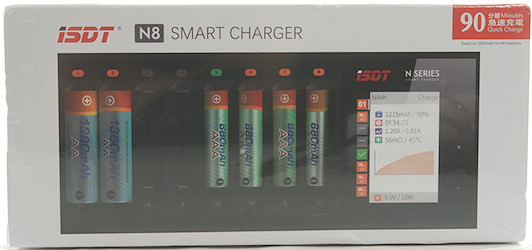



I got the charger in a cardboard box with a picture of it, but no specifications.

The pack included the charger, a usb cable and a instruction sheet. The instruction sheet is for all 3 N chargers.

The charger is usb powered and can use either normal USB or QC.
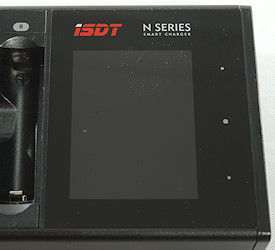
The user interface is a color LCD screen, a multicolor led for each slot and 3 touch buttons on the right side. The buttons are up/down and select/enter, the select/enter needs a long press to show the menu.
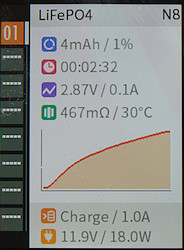
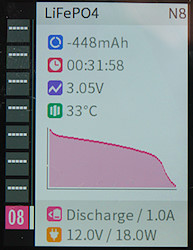
There is a lot of information on the screen, both about the batteries (one at a time), actual mode and input power.
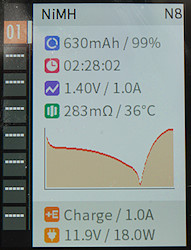
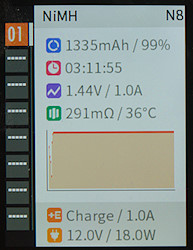
The charger has a special "Activation Charge" mode, this means the battery will be discharge before it is charged. The % rating is a bit on the silly side and it is not because I have selected NiMH instead of Eneloop!
The curve do not show from start to finish, but only the last maybe two hours of the program.

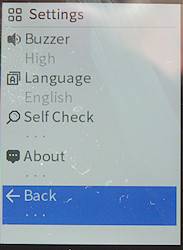
A long "press" on the center button will bring up the menus, this does not suspend the current operation. Selection will first be activated when "Back" is touched.
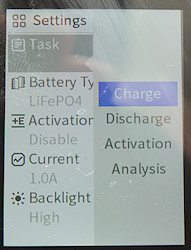
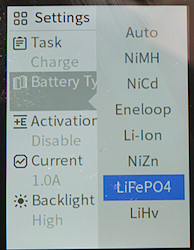
Some of the selections in the menus. The current can be selected from 0.1A to 1.5A in 0.1A steps for charging. For discharging the maximum is 1A.
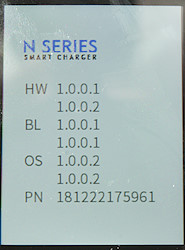
With this charge the software version is not a single piece of software.
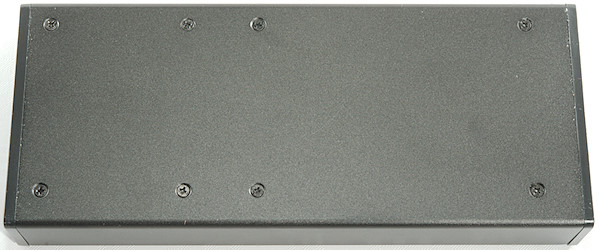


Most of the charger body is made in metal.
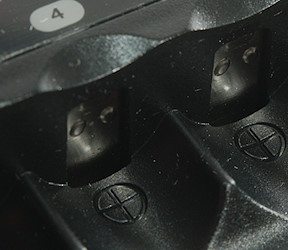
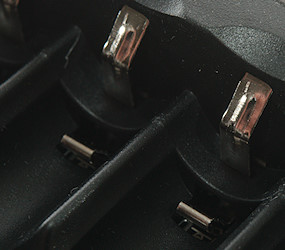
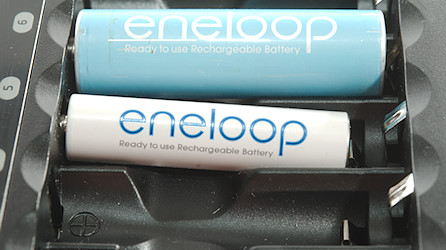
The slots are the common two level AA/AAA slots with mechanical polarity protection, this also prevents the charger from handling flattop batteries.


Only unprotected button top cells will fit.
Measurements charger
- From USB the charger reports 10W available (2A).
- Power consumption from USB when idle is 130mA with display on and 95mA with display off.
- Uses 12V from QC and reports 18W available (1.5A).
- Power consumption from QC 12V when idle is 70mA with display on and 55mA with display off.
- Display will automatic turn off after some time when the charger is idle.
- All slots uses the same settings
- Supported chemistries: NiMH, Eneloop, NiCd, NiZn, LiIon, LiIonHV
- Functions: Charge, Charge with refresh for NiMH/NiCd, Discharge, Activation, Analysis
- Without power it will not discharge a batteries with any significant current
- The charger will remember last settings and use them next time it is powered on.
- The charger supports firmware update.
- The charger has an automatic mode that can handle NiMH, NiCd, LiFePO4 and LiIon
Charging NiMH
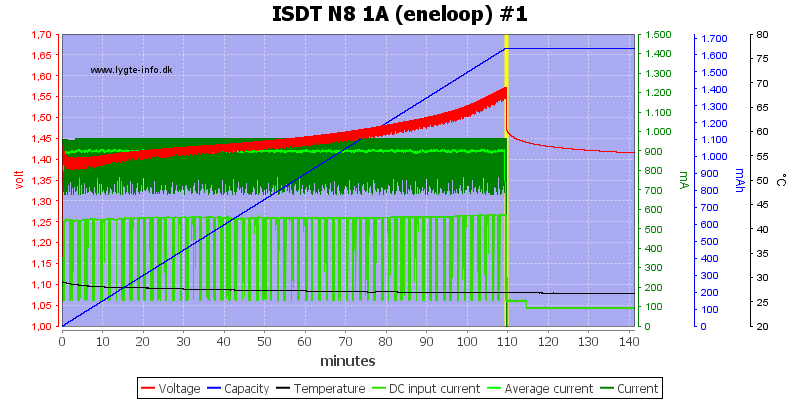
This looks like a voltage termination and there is no trickle charge.
Display shows: 1759mAh, 1:50:17, 380mOhm
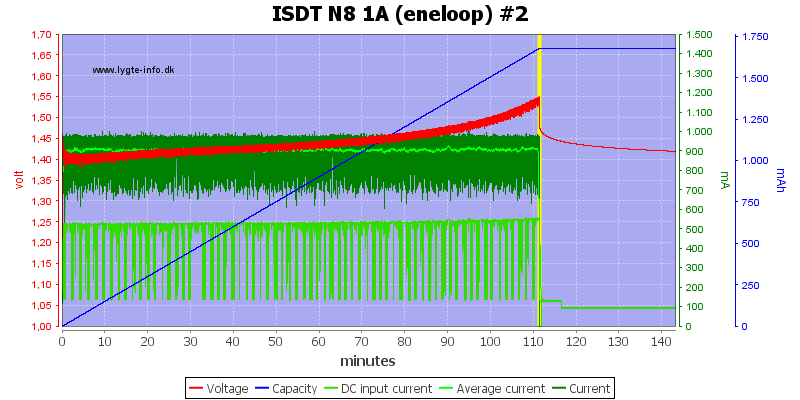
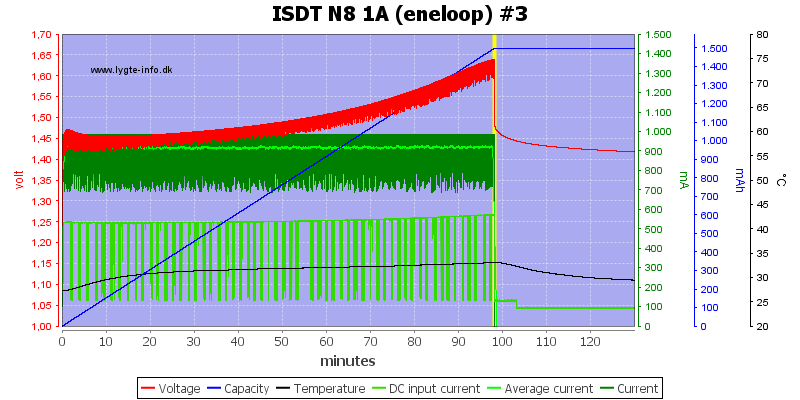
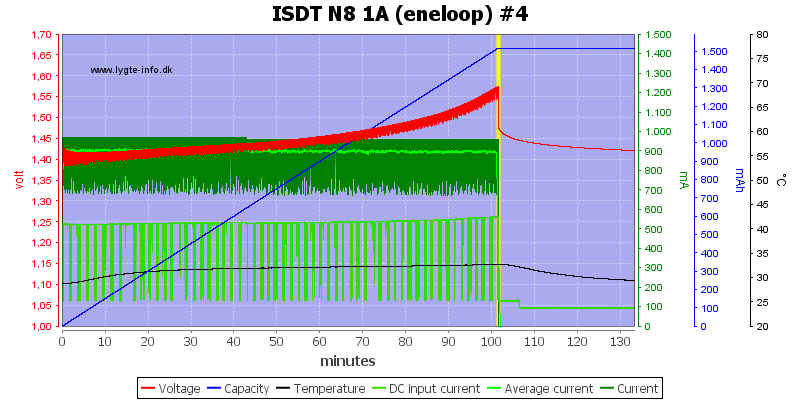
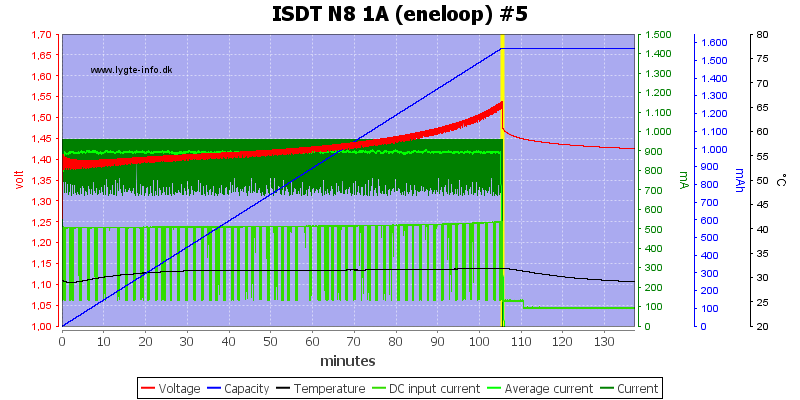
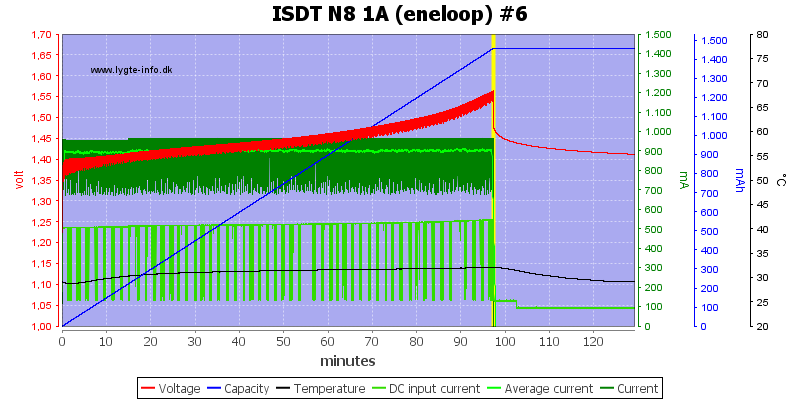
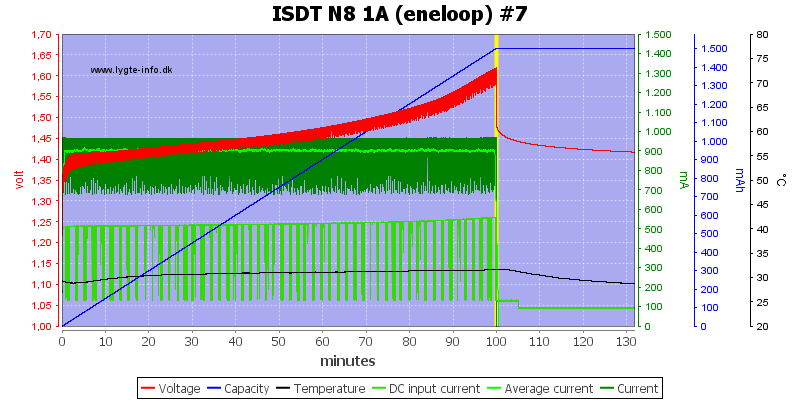
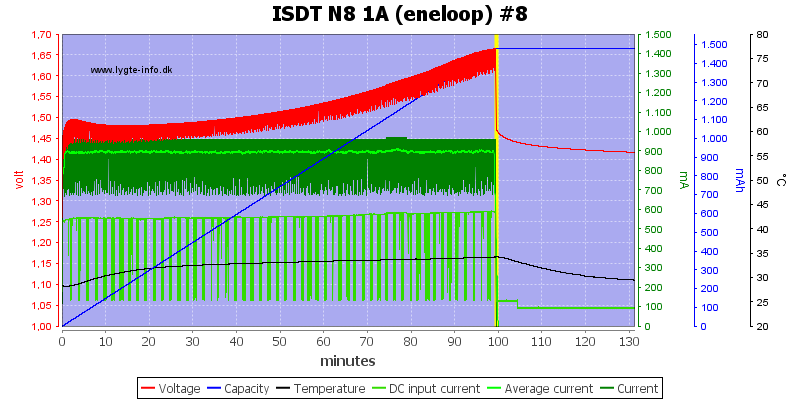
They all looks like voltage termination, but there is some difference in voltage, none of them has a obvious temperature raise at the end to signal full battery.
Display shows: #2 1760mAh, 1:52:12, 260mOhm
Display shows: #3 1568mAh, 1:38:45, 339mOhm
Display shows: #4 1635mAh, 1:42:06, 304mOhm
Display shows: #5 1693mAh, 1:46:03, 215mOhm
Display shows: #6 1570mAh, 1:37:58, 254mOhm
Display shows: #7 1619mAh, 1:40:38, 279mOhm
Display shows: #8 1601mAh, 1:40:01, 465mOhm
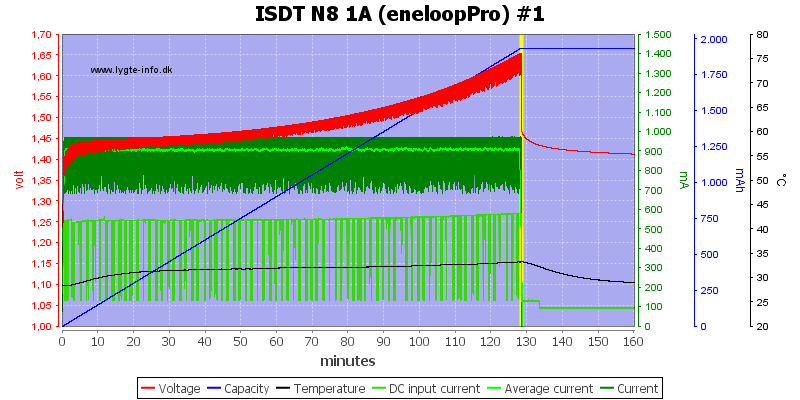
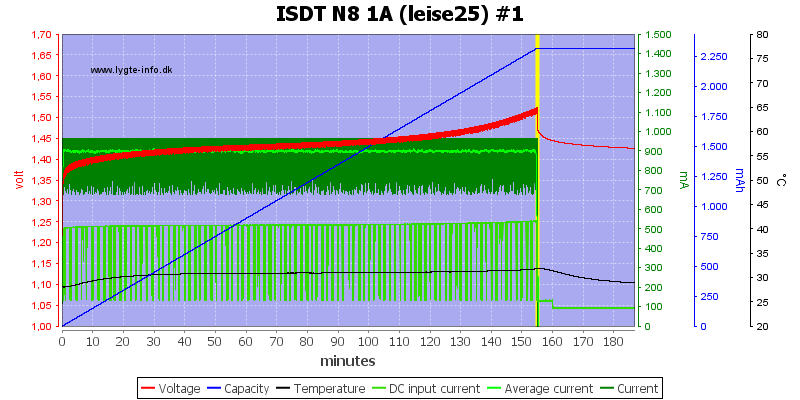
The termination voltage varies, i.e. the circuit must do more than just terminating at a specific voltage.
Display shows: leise25 2489mAh, 2:35:54, 234mOhm
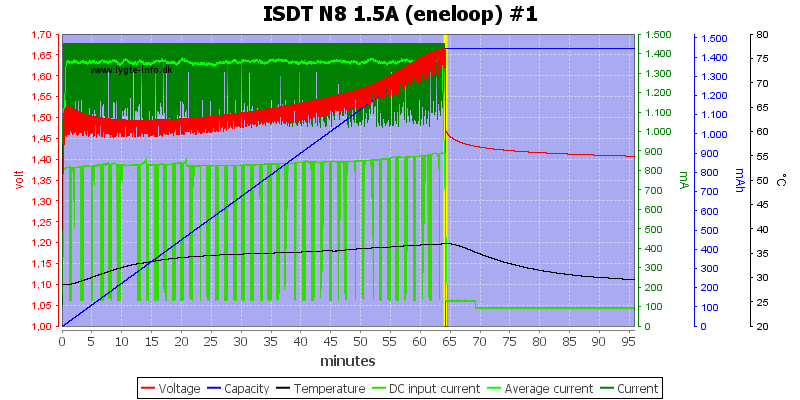
Maximum charge current is 1.5A.
Display shows: 1537mAh, 1:09:33, 355mOhm
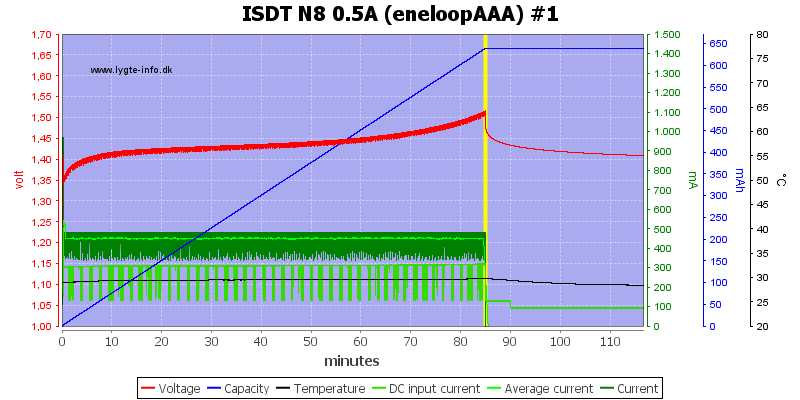
It handles a AAA at 0.5A as expected.
Display shows: #8 690mAh, 1:25:32, 211mOhm
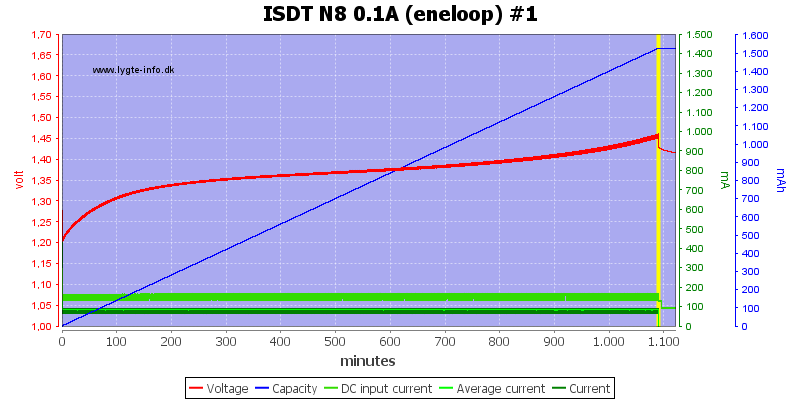
Minimum current is 0.1A and it do terminated.
Display shows: #8 1682mAh, 18:16:19, 494mOhm

A full battery is terminated fairly fast with the termination method used. Here it takes 5 minutes.

The charger has a special charge option for NiMH/NiCd batteries, this means they will be discharge each time they are charged. This test was done with a new Eneloop.
Display shows: 1868mAh, 3:45:05, 272mOhm
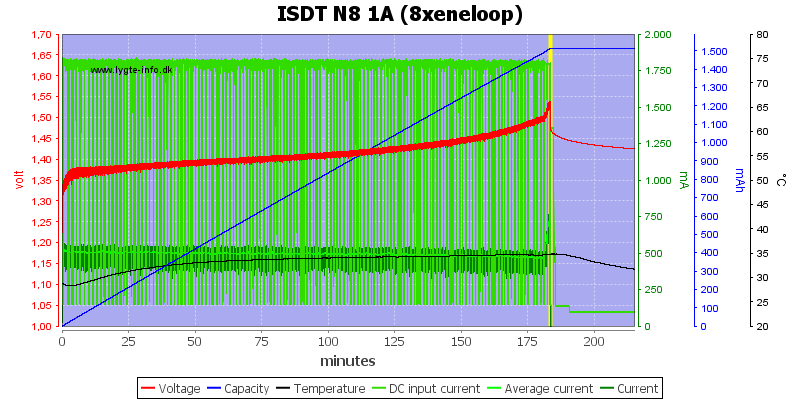
8 batteries with 1A charge current selected, the actual charge current is 0.5A and it uses nearly 2A from the USB power.
Display shows: #1 1644mAh, 3:04:47, 262mOhm
Display shows: #2 1645mAh, 3:02:37, 207mOhm
Display shows: #3 1637mAh, 3:03:39, 301mOhm
Display shows: #4 1637mAh, 3:03:13, 268mOhm
Display shows: #5 1712mAh, 3:06:12, 174mOhm
Display shows: #6 1646mAh, 3:04:55, 253mOhm
Display shows: #7 1708mAh, 3:06:11, 188mOhm
Display shows: #8 1715mAh, 3:06:50, 206mOhm
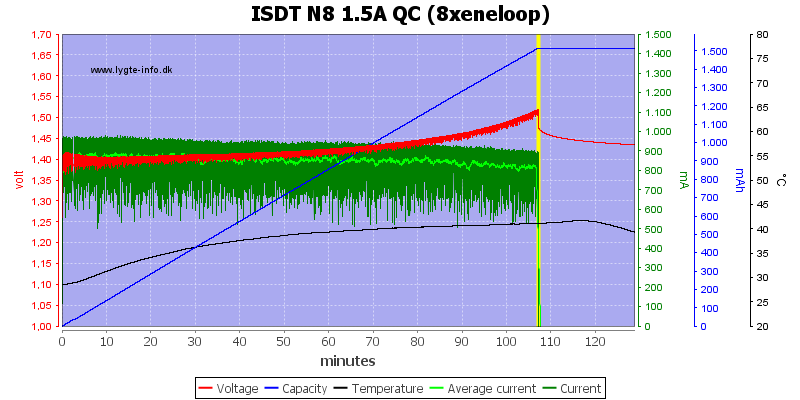
When using a QC supply the maximum charge current is increased to 0.8A.
Display shows: #1 1639mAh, 1:47:45, 263mOhm
Display shows: #2 1864mAh, 1:56:59, 117mOhm
Display shows: #3 1807mAh, 1:57:09, 171mOhm
Display shows: #4 1879mAh, 1:56:58, 157mOhm
Display shows: #5 1882mAh, 1:56:47, 167mOhm
Display shows: #6 1834mAh, 1:57:01, 281mOhm
Display shows: #7 1834mAh, 1:56:32, 226mOhm
Display shows: #8 1834mAh, 1:58:23, 172mOhm
It is interesting to compare these numbers with the ones from normal USB, the batteries needs nearly 200mAh more charge when charged from QC?
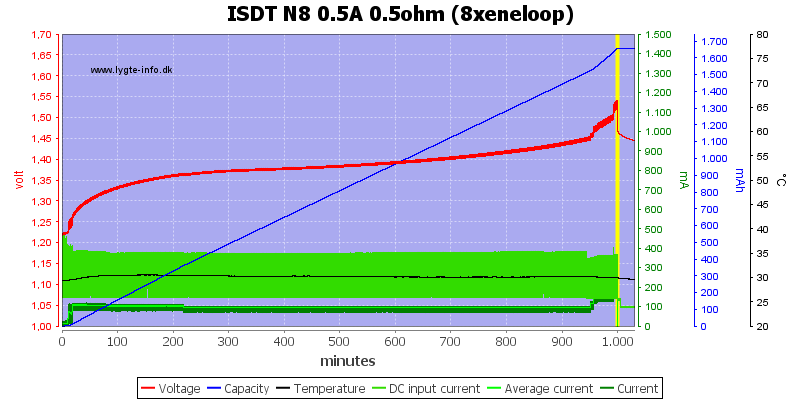
Adding a 0.5ohm resistor in series with the power supply to simulate a long cable or weak supply slows down the charger significantly, but it will charge the batteries.
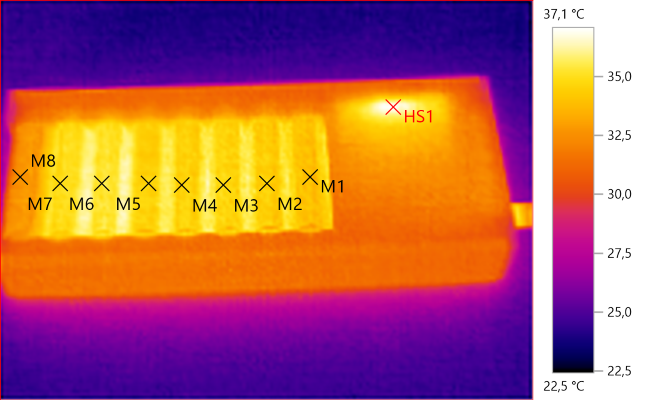
M1: 34.1°C, M2: 34.7°C, M3: 34.8°C, M4: 34.5°C, M5: 34.7°C, M6: 35.3°C, M7: 34.8°C, M8: 32.8°C, HS1: 37.1°C
This is charging from USB

HS1: 38.1°C
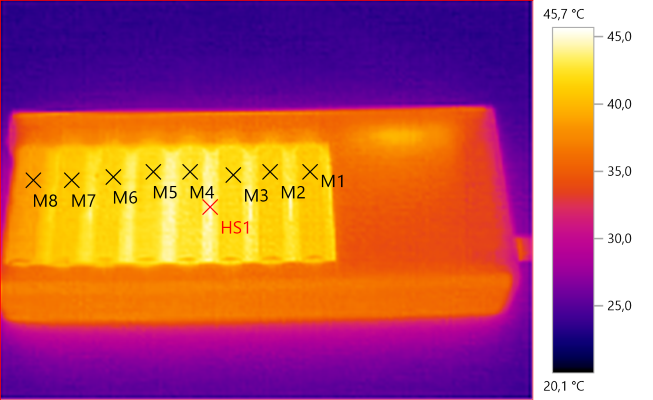
M1: 41.1°C, M2: 41.2°C, M3: 41.9°C, M4: 42.9°C, M5: 41.7°C, M6: 41.9°C, M7: 41.0°C, M8: 38.8°C, HS1: 45.7°C
This is charging from QC

The charger needs a few seconds to turn on.
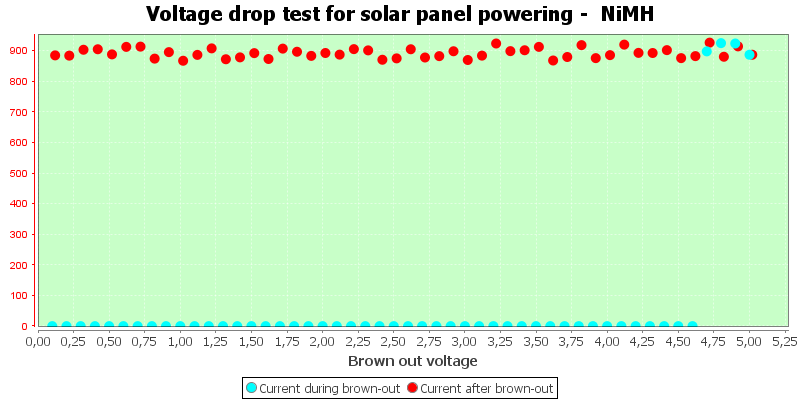
The microprocessor in this charger has a good reset/watchdog circuit and has no problems with unstable supply. It will, of course, restart charging each time the voltage drops.
Discharging NiMH
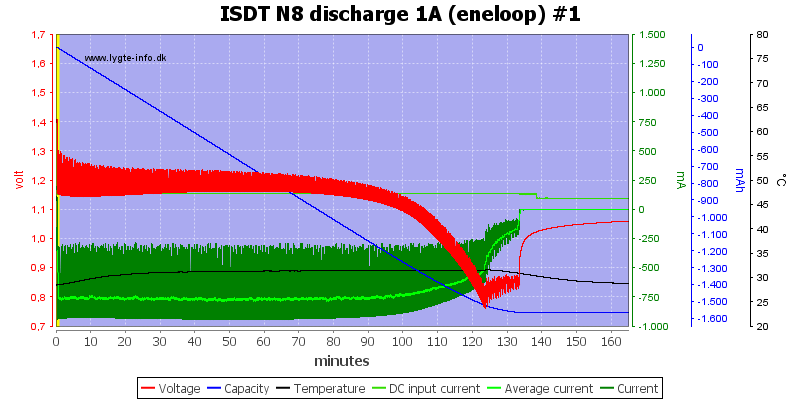
The discharge is not constant current, the average is about 0.8A for the selected 1A. When the battery voltage gets low the current will drop. The discharge stops around 0.8V
Display shows: 1855mAh, 2:13:56
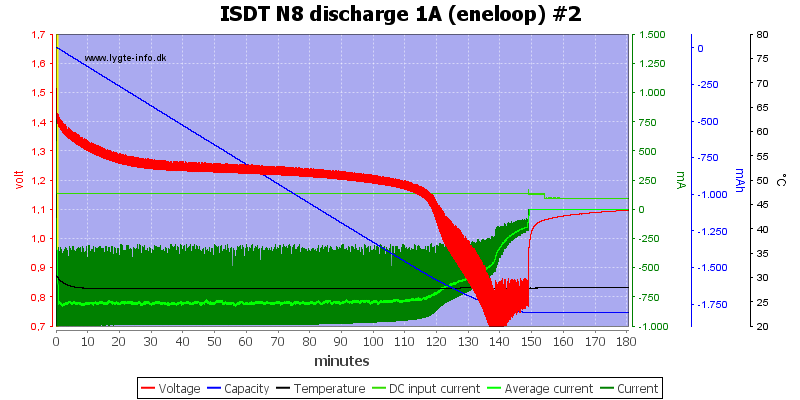

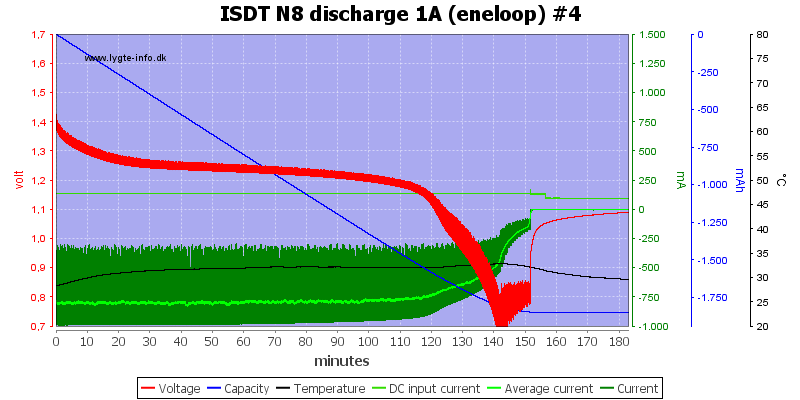
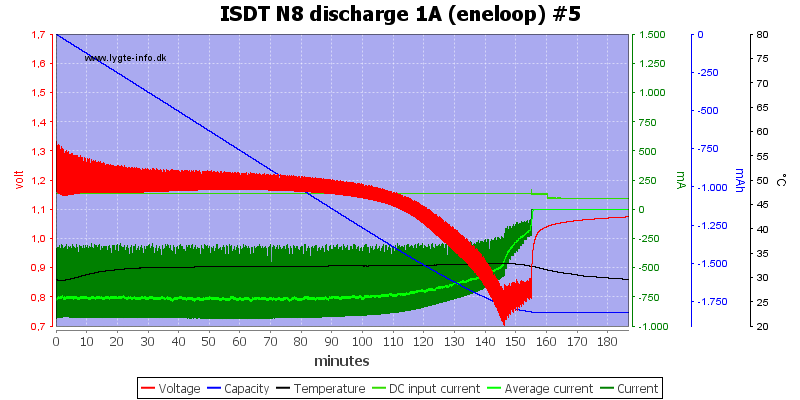
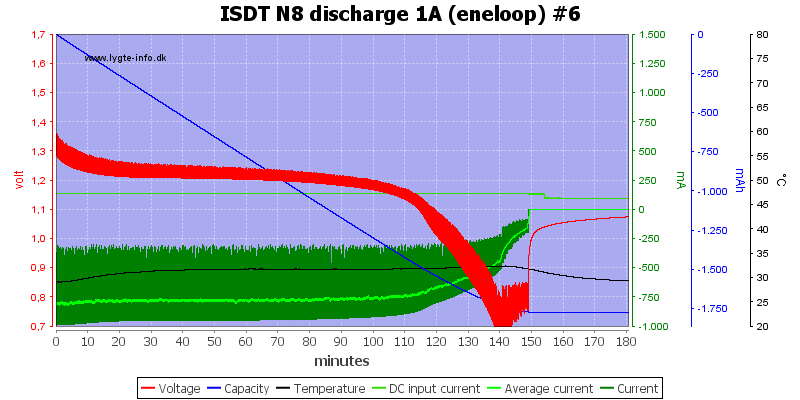
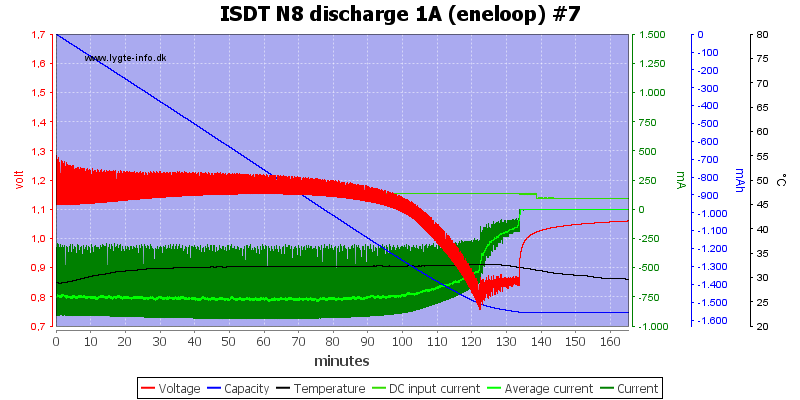
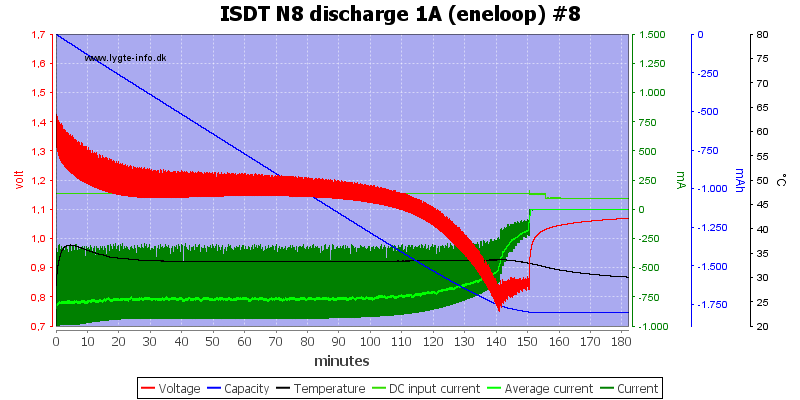
Display shows: #2 2163mAh, 2:29:43
Display shows: #3 2054mAh, 2:22:27
Display shows: #4 2209mAh, 2:32:26
Display shows: #5 2161mAh, 2:36:07
Display shows: #6 2099mAh, 2:29:58
Display shows: #7 1834mAh,
Display shows: #8 2133mAh, 2:31:26
Interesting to see how much capacity my eneloop has during discharge, this looks rather optimistic, especially when a charge is below 1900mAh.
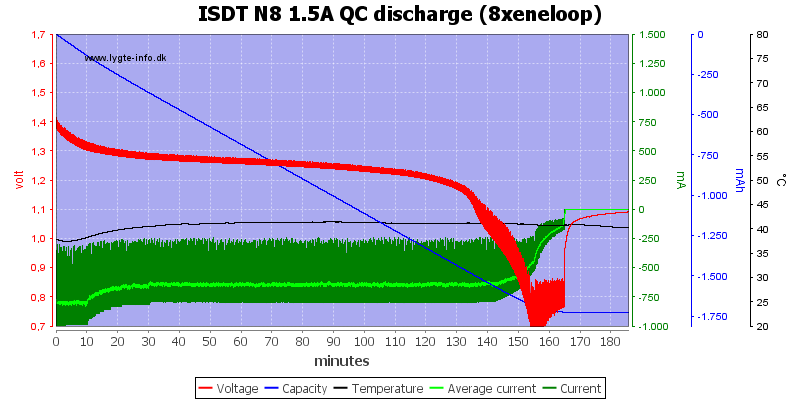
Even with 8 batteries the discharge current is close to 0.8A
Display shows: #1 2070mAh, 2:46:23
Display shows: #3 1993mAh, 2:47:41
Display shows: #4 2114mAh, 3:00:02
Display shows: #5 2008mAh, 3:22:55
Display shows: #6 1955mAh, 3:15:58
Display shows: #7 1992mAh, 2:35:54
Most slots must have reduced the current a bit more, due to temperature.

M1: 45.5°C, M2: 46.1°C, M3: 46.2°C, M4: 46.6°C, M5: 46.5°C, M6: 46.7°C, M7: 46.0°C, M8: 43.2°C, HS1: 51.3°C
With discharging the charger need to burn some power, as can be seen it is done below the batteries and will heat them up.
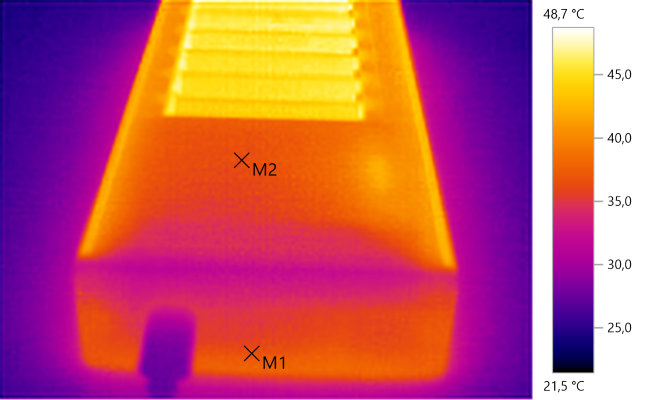
M1: 36.7°C, M2: 36.7°C

The charger pulses the current to measure voltage, but the regulation is analog (Discharge current is the select 0.5A).
Analysis NiMH
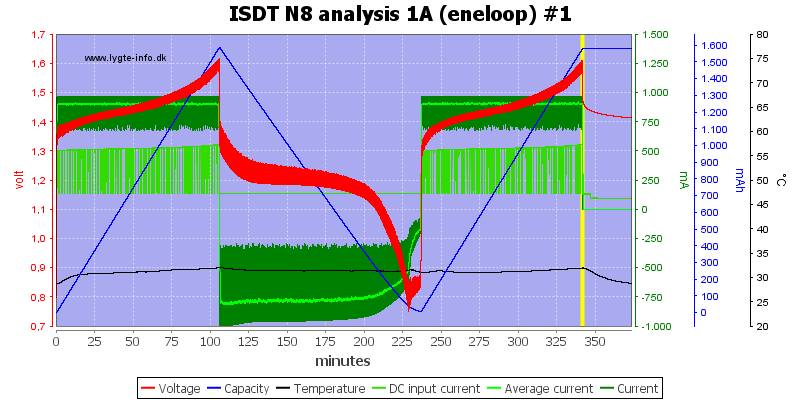
The analysis function will charge/discharge/charge a battery to measure capacity.
Display shows: 1694mAh, 5:47:43 278mOhm
Activation NiMH

Activation runs 3 charge/discharge cycles on the battery, this will usual bring a NiMH battery up to maximum capacity.
Display shows: 1623mAh, 9:22:21 387mOhm
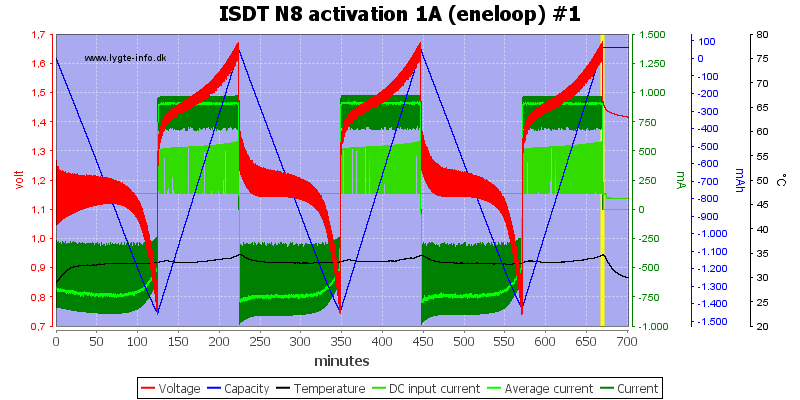
When starting with a full battery the first charge is skipped.
Display shows: 1594mAh, 11:14:15 389mOhm
Other batteries
The charger support many different battery types, the problem is that they do not fit in the charger, it will only accept button top batteries in AA/AAA size.
With LiIon batteries there is also another restriction: The charger must be powered from QC or it will not charge, but there is no error message!
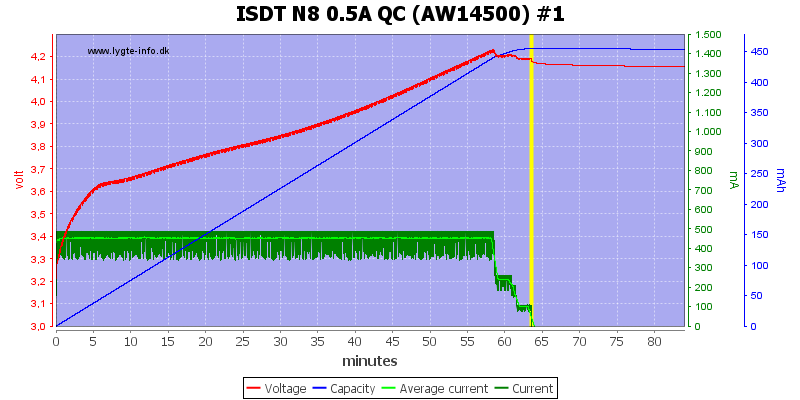
The charger maintains constant current until battery is above 4.2V, then it drops current fast, before terminating at 0.1A. The charging looks fine.
Display shows: 491mAh, 286mOhm, 4.17V
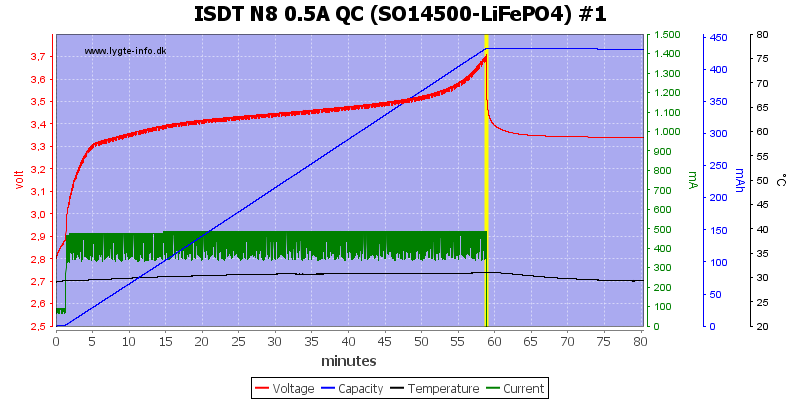
The charger uses a low current until the battery reaches 2.9V, then full charge current is used, with these batteries there is no tapering of the current, the charge is terminated when 3.7V is reached.
Display shows: 466mAh, 267mOhm, 3.35V
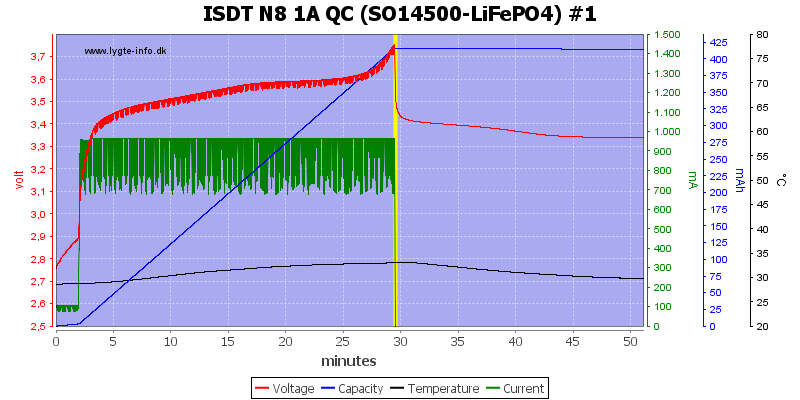
I could also use 1A charge current for the LiFePO4 battery.
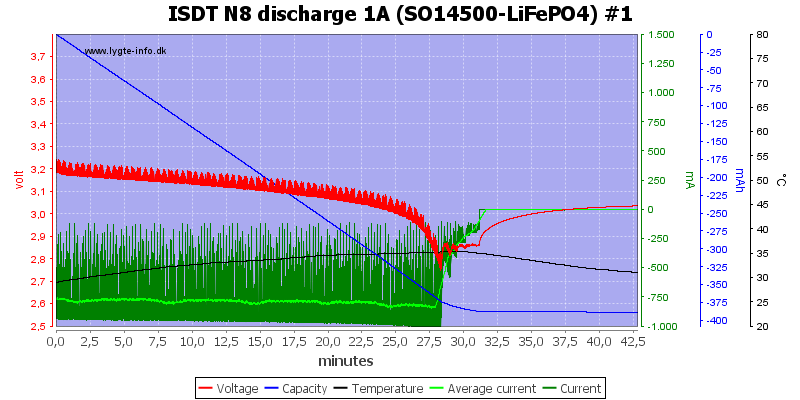
LiFePO4 batteries are discharged to about 2.75V or is it 2.85V. At 2.75V the current is reduced and the charger stays at 2.85V for some time.

If the battery voltage is below 2.9V with LiFePO4 the charge current will be limited as could also be seen on the charge curve.

Above 2.9V the charger goes to full charge current. The current is slowly ramped up.
Internal resistance
I have done the IR measurement different this time. There are a couple of reasons for this: My test equipment could not fit between battery and charger, I did not really want to manually do 400 measurements and I have made some equipment to fairly easy measure the IR of batteries with good precision.
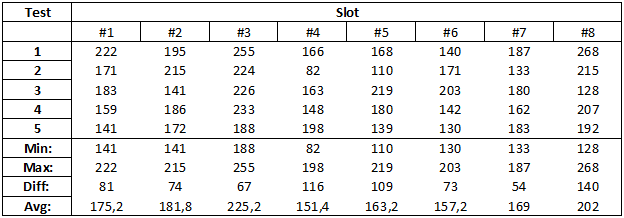
All measurement is made with the same battery in 0.1A NiMH charge mode. The correct IR of the battery (A new Eneloop) is between 30mOhm and 50mOhm, depending on how it is measured.
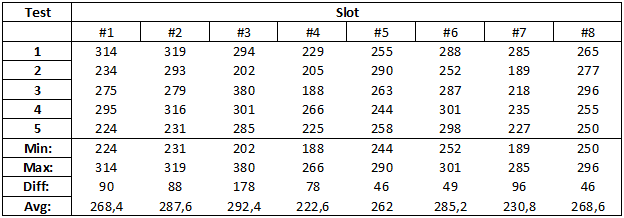
This is done with a old LiFePO4 cell, again all measurements are done with the same cell in 0.1A LifePO4 charge mode. The correct IR of the battery is between 110mOhm and 130mOhm, depending on how it is measured.
Conclusion
I like the metal enclosure, the display and buttons also works fine, but I would have liked some sort of status screen for all the batteries. The leds for each slot and the icons at the left of the screen show status, but not time, mAh or voltage, and it takes some time to check each slot on the display.
The charging uses some sort of voltage termination for NiMH and without top-off, this is good for battery lifetime (If the batteries stay cool), but means the batteries will not be completely filled.
The capacity display is not very precise, but is still very useful. The internal resistance is mostly useless.
The support for many battery types is only partial useful, NiZn and LiFePO4 will fit, but very few LiIon will fit.
This charger and the larger models may be very useful to keep a huge set of NiMH batteries charged and verify their capacity, i.e. when to replace them, but for charging a couple of batteries at home it is a bit of overkill, except if you use a lot of LiFePO4 and NiZn in AA/AAA size.
I will rate the charger fairly good.
Notes
The charger was supplied by Banggood for review.
Here is an explanation on how I did the above charge curves: How do I test a charger








































































